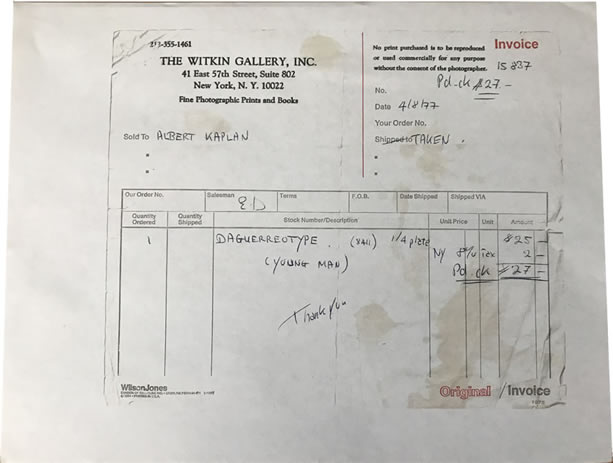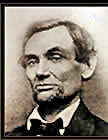by Albert Kaplan
The management of the art gallery from whom I purchased the daguerreotype refused to provide me with any information concerning its source. Here is a photocopy of the receipt.

The Date
Grant Romer of the George Eastman House believes that it was studio made in the early 1840's, in an urban setting, by a first-rate professional daguerreotypist.
According to plastic and reconstructive surgeons, other physicians, and forensic specialists, Lincoln appears to be 31-32 years of age. If they are correct, Lincoln, born on February 12, 1809, would have sat for the daguerreotype in 1840 or 1841.
At the 1994 International Association of Identification Press Conference at the Lincoln Library, Springfield, Illinois, Dr. Claude Frechette stated that Lincoln's weight at the time of the sitting suggested that the daguerreotype might have been made in 1840. He elaborated by recounting the historical evidence of Lincoln's severe weight loss beginning on or very close to January 1, 1841. In early 1841, James C. Conkling wrote to his fiancee, Mercy Levering, a friend of Mary Todd: "Poor Lincoln! How are the mighty fallen! He was confined about a week but though he now appears again he is reduced and emaciated in appearance." After reading aloud Mr. Conkling's description, Dr. Frechette said, "Clearly, at the time of the sitting, Lincoln was not "emaciated in appearance".
I took this up with Mr. Romer, and asked him if it was possible that the daguerreotype was made as early as 1840 or 1841. He replied that it was possible, but unlikely. He especially discounted 1840.
Whenever, wherever, and by whom it was made, we know that two elements were essential: Lincoln and a daguerreotypist needed to be in the same place at the same time. "Lincoln Day-by-Day" gives us Lincoln's whereabouts. In 1840 he remained in Illinois. I asked photographic historian, John S. Craig of Torrington, Connecticut, if he could place any daguerreotypists in Illinois in 1840. He replied that there is no record of any daguerreotypists in Illinois in 1840, and none in Springfield in 1841. He informed me, however, that in August 1841 Thomas R. Whitney "advertised himself in Galena, Illinois, as a daguerrean, remaining there approximately a month." However, according to "Lincoln Day-by-Day", Lincoln was not in Galena at that time.
Nor does it seem that Lincoln was in Galena in December 1841 at which time, according to Mr. Craig's remarkable records, "Richard Plumbe, brother of John Plumbe, Jr., noted daguerrean of Boston, exhibited daguerreotypes at a store in Galena. He probably also operated a temporary gallery there at that time."
The Place
In August 1841 Lincoln and his friend, Joshua Speed, traveled to the Speed plantation in Louisville, Kentucky. He and Speed departed Springfield for Louisville on August 12, 1841, arriving on approximately August 18th. They departed Louisville on September 7th, passing through St. Louis on their way back to Springfield.
The Circumstances
Lincoln was a house guest of the dearly loved Speed family. I suggest that if the daguerreotype was made in Louisville, Lincoln gave it as a gift to his hostess, Mrs. Lucy C. Speed, Joshua's Mother, the very same lady he sent a signed photograph of himself when President. On the occasion of his visit to Louisville she gave Lincoln a gift, a Bible.
While this scenario is not certain, it is possible. The daguerreotype would have remained in the personal possession of Mrs. Speed until an unknown date and unknown circumstance. Somehow, someway, 136 years later, the daguerreotype found its way to the gallery on 57th Street in New York City where I purchased it.
T. B. Moore, a medical doctor/dentist and daguerreian, of the itinerant daguerreian team of Moore & Ward, is largely lost to us. We know almost nothing about him or Mr. Ward.
Fate brought him to Louisville, Kentucky in August/September, 1841.
His knowledge of photography had to have been encyclopedic. Moore created a photographic masterpiece. It is a photographic masterpiece without the identity of the sitter known! It just happened that young Abraham Lincoln was the sitter! Fate brought a brilliant man, Moore, together with a visitor to Louisville from Springfield, Illinois, a guest of Mrs. Lucy Speed. (I had the privilege of visiting what was the Speed Plantation, and visited the still standing, and well-maintained stone house.)
Lincoln went to see a dentist in Louisville. We do not know the name of the dentist. We do know that Lincoln brought along his own chloroform, and this was around four years before chloroform was accredited. We also know that the anticipated extraction was performed in Springfield at a later date. It seems possible to me that the dentist Lincoln consulted in Louisville was the visiting physican/dentist/daguerreian T. B. Moore.
Dissenting Opinions
The reader may agree that there is compelling circumstantial evidence supporting the daguerreotype having been made in Louisville, Kentucky in late August/early September 1841.
However, Grant Romer, the recognized world authority of early photography, discounted 1841. My circumstantial evidence pointing to 1841 made no impression on him. He told me, "I have never seen an 1841 daguerreotype of this quality". On two subsequent occasions Grant told me that, considering its overall quality, the earliest date he is comfortable with is 1844! However, he conceded that earlier dates were possible. He said, "possible, but unlikely, and the earlier you go the more unlikely".
Another early photography authority, Ralph Wiegandt, using specialized electronic equipment, performed a scientific experiment on the daguerreotype with a view to narrowing down its date. Ralph explained that from 1842 onward minute particles of gold were often used in the plate-making process. Therefore, he reasoned, if particles of gold were found, it would suggest that the plate was produced post-1841.
And, he struck gold!
Here is Ralph's report:
I was able to get a fairly conclusive signal through the glass of the XRF spectrum indicating the presence of gold on the plate. I compared this to known plates with gold, both without glass and with 19th C glass that contains significant lead. The signal distortion created by the distance of the sensor from the plate due to the glass, and the metals in the glass were overcome adequately to determine the difference between the gold stabilizing that was endemic to the process after 1842 and the earliest daguerreotypes that did not have the gold process. This is also consistent with the appearance and condition of your plate, which has all the appearance of a later more evolved and superior image that the gold imparts to the images. This quite conclusively moves the date attribution of this daguerreotype to a post 1842 period. Beyond that determination, I do not think we are able to say more about the age of this particular daguerreotype from primary material analysis.
All the best,
Ralph
Ralph WiegandtSenior Project Conservator
George Eastman House International Museum of Photography and Film
900 East Ave
Rochester, New York 14625
(585) 271 3361 x388
In conclusion, we have two early photography authorities that are not overjoyed with my suggested 1841 date, views that deserve respect and consideration.

